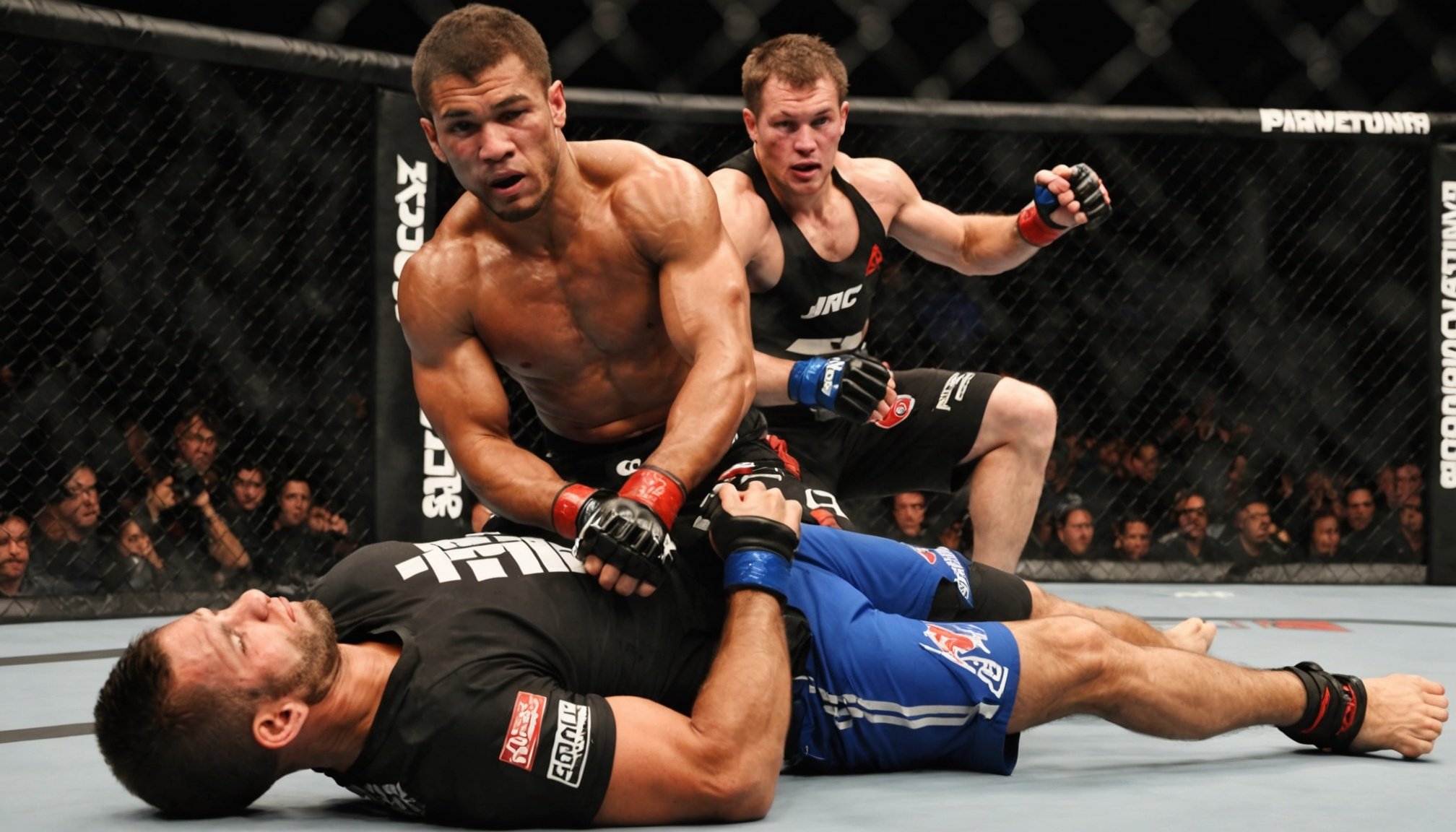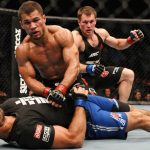Common Injuries Sustained by Mixed Martial Arts Athletes
Understanding the Prone Challenges
In the world of MMA, fighters face a high risk of various MMA injuries due to the sport’s intense physical demands. The most common MMA injuries include fractures, sprains, concussions, and lacerations. Fractures often affect the hands and feet, resulting from strikes or falls, while sprains typically involve joints like the ankle or wrist, caused by sudden twists during grappling or takedowns. Concussions are another critical concern, as head impacts frequently occur from punches or kicks, posing serious neurological risks if not managed properly.
Also to discover : How Can UK Combat Sports Evolve and Improve in the Next Decade?
These types of injuries in MMA arise both during rigorous training and live competitions. During training, repetitive motions and high-impact drills contribute to wear and tear on joints and muscles. In competitions, athletes push their limits, raising the chance of acute trauma. The combination of striking, grappling, and submission maneuvers creates multiple injury vectors.
Immediate treatment of common MMA injuries involves on-site assessment, focusing on stabilizing fractures and controlling bleeding from lacerations. Concussions require careful neurological evaluation to prevent long-term damage. Prompt detection and care play an essential role in protecting the athlete’s health and career longevity.
Also read : What Are the Key Challenges Facing UK Combat Athletes Today?
Rehabilitation Strategies and Medical Treatment
Recovery from an MMA injury requires a structured, step-by-step approach to ensure effective healing and return to peak performance. Initially, accurate diagnosis guides acute care, focusing on reducing pain and inflammation. This phase may involve rest, ice application, and anti-inflammatory medication.
Following immediate care, long-term rehabilitation becomes crucial. Sports medicine for MMA champions rehabilitation with personalized exercise plans that restore strength, flexibility, and range of motion. Physical therapists play a central role by monitoring progress, correcting movement patterns, and preventing re-injury.
Advanced recovery techniques enhance traditional therapy. Cryotherapy, for example, reduces inflammation by applying extreme cold to affected areas. Ultrasound therapy promotes tissue healing by stimulating blood flow. Meanwhile, Platelet-Rich Plasma (PRP) therapy leverages the body’s own healing factors to accelerate recovery. These modalities, combined with expert guidance, expedite healing.
In summary, MMA injury rehabilitation is a tailored process integrating professional care with cutting-edge technology. Understanding the collaboration between physical therapists and sports medicine professionals is key to effective recovery techniques that help fighters return stronger and safer.
Importance of Rest, Physical Therapy, and Gradual Return
Balancing MMA rest periods with targeted rehabilitation is essential in the injury recovery process. Fighters who rush back too soon increase the risk of reinjury and prolonged downtime. Implementing structured rest periods allows the body to begin healing optimally without undue stress.
Physical therapy for fighters goes beyond generic rehab exercises. It focuses on movements specific to MMA, such as rotational core work, explosive lower-body drills, and joint stabilization techniques. These tailored exercises rebuild strength and mobility in a way that mimics actual fight conditions, directly enhancing recovery efficiency.
A gradual return is crucial. Starting with light activities like stretching or shadowboxing encourages blood flow and flexibility without straining injured areas. Progressing slowly to bag work and controlled drilling readies muscles and joints for impact. Only when these steps are successfully managed should fighters resume full-contact sparring.
This staged approach ensures the injury is truly healed and performance standards meet pre-injury levels. Adequate rest combined with physical therapy for fighters creates a solid foundation for a safe and effective return to training and competition.
Nutritional Support for Injury Recovery
Fueling the body’s repair and resilience
Nutrition for MMA recovery plays a vital role in accelerating tissue repair and reducing inflammation after injuries. The body demands increased energy and specific nutrients to rebuild damaged muscles and connective tissues effectively. Protein for athletes is essential because it provides the amino acids necessary for repairing muscle fibers and synthesizing new tissue. High-quality protein sources like lean meats, dairy, and plant-based options support this process well.
Supplements for injury healing often focus on amino acids such as branched-chain amino acids (BCAAs), which help stimulate muscle protein synthesis and limit muscle breakdown. Omega-3 fatty acids reduce inflammation by modulating the immune response, thereby decreasing swelling and pain that can delay recovery. Vitamins, particularly vitamin C, support collagen formation, a key structural protein in wound healing.
Hydration’s role in tissue healing should not be underestimated. Adequate fluid intake maintains cellular function and nutrient transport, essential for wound repair. Keeping hydrated also helps regulate inflammation and flush out metabolic waste from injured areas.
For athletes focused on nutrition for MMA recovery, balancing these elements ensures a comprehensive approach to healing and returning to peak performance efficiently.
Mental Health and Psychological Resilience During Recovery
Understanding the psychological landscape of healing
Injured MMA athletes often face significant psychological challenges such as anxiety, depression, and frustration during their mental recovery MMA journey. The disruption to their routine and uncertainty about the future can amplify stress levels, making psychological support for injured athletes essential.
A robust mindset for recovery forms the cornerstone of healing. Integrating mental strategies like mindfulness allows athletes to stay present, reducing anxiety tied to past injuries or future performance worries. Setting clear, achievable goals during rehabilitation keeps motivation high and provides a sense of progress.
Support systems play a pivotal role. Access to sports psychologists helps athletes process their emotions constructively. Additionally, encouragement from coaches, medical teams, and peers fosters resilience by creating a network focused on holistic recovery.
By combining psychological support for injured athletes with mindfulness and goal-setting, mental recovery MMA becomes a comprehensive process. This approach not only addresses physical healing but also equips athletes with mental tools crucial to overcoming setbacks and returning stronger both mentally and physically.
Recovery Timelines and Real-World Examples from Professional Fighters
Understanding injury recovery in MMA through actual experiences
Recovery timelines MMA fighters face depend heavily on the injury type and severity. For example, a simple muscle strain might heal within two to four weeks, while ligament tears or bone fractures often require months. Typical recovery timelines MMA athletes experience range from several weeks for minor injuries to six months or more for complex surgeries.
Athlete injury stories from professional fighters highlight the variability and resilience required. One fighter returned from an ACL tear after nine months, employing both surgery and a focused rehab regimen emphasizing strength and mobility. Another case involved a broken hand, which healed in about six weeks, but required careful injury management to avoid long-term complications.
Real recovery case studies reveal how setbacks like inflammation or re-injury are managed. Fighters often adapt their training, embracing physiotherapy, nutrition, and rest to overcome hurdles. The recovery process is rarely linear, underscoring the importance of patience and expert guidance.
Incorporating these lessons improves overall outcomes. By understanding recovery timelines MMA professionals endure, both aspiring and seasoned athletes can set realistic expectations and adopt effective recovery strategies tailored to their unique situations.
Expert Advice and Best Practices for MMA Injury Recovery
Insights from professionals to speed up healing and return safely
Professional MMA recovery tips emphasize combining medical guidance with tailored rehabilitation programs. Experts recommend consulting sports physicians to diagnose injuries accurately and supervise treatment. This approach ensures that recovery protocols align with individual injury severity and athlete needs.
Best practices for athlete recovery highlight the importance of gradual reintegration into training. Starting with low-impact exercises and physiotherapy under supervision helps restore mobility and strength without jeopardizing healing. Coaches stress communication with medical professionals to adjust training intensity appropriately.
Preventing future injuries is another cornerstone of expert MMA recovery tips. Pro athlete recommendations include maintaining proper technique, prioritizing warm-ups and cool-downs, and strengthening key muscle groups to enhance joint stability. Incorporating flexibility and balance exercises reduces vulnerability to trauma.
Managing psychological readiness is equally crucial. Experts advise athletes to set realistic recovery goals, reducing pressure and supporting mental resilience during downtime.
By following structured guidelines and listening to expert advice, fighters can achieve optimal recovery, minimise reinjury risks, and confidently return to competition stronger than before.


